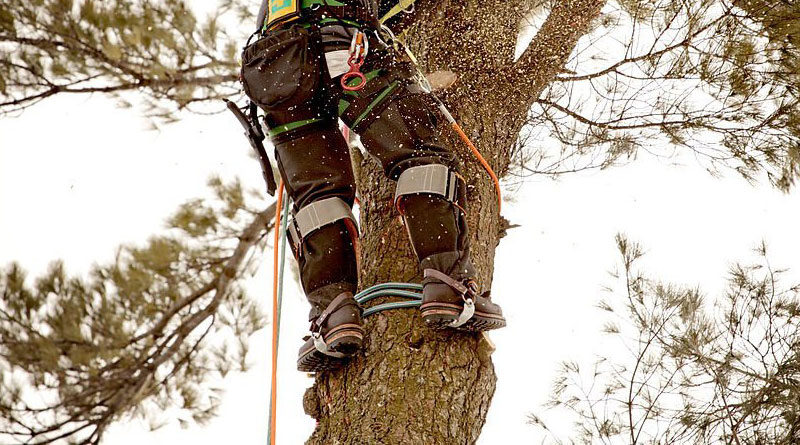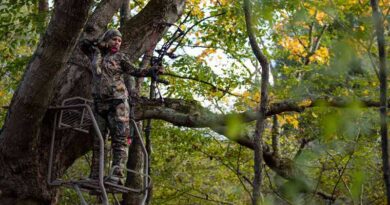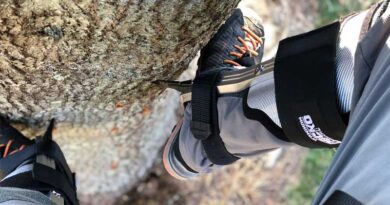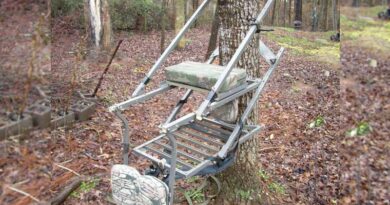Do Climbing Spikes Hurt Trees?
Yes, climbing spikes can hurt trees. Climbing spikes are metal or plastic spikes attached to the climber’s boots or shoes that enable them to climb trees quickly and easily. When a climber uses spikes to climb a tree, it can damage the tree’s bark and cambium layer, which can affect the tree’s overall health and survival.
Climbing spikes can cause long-term damage to a tree by creating wounds that allow insects and diseases to enter, potentially resulting in decay and death. Climbing spikes can also stress the tree, making it more susceptible to environmental stresses like drought, extreme temperatures, and storms.
For these reasons, many arborists and tree care companies avoid using climbing spikes unless the tree is being removed or heavily trimmed. To avoid damaging the tree, they use other climbing methods such as rope and harness systems.
How Do Climbing Spikes Work?
Climbing spikes, also known as spurs, are metal or plastic spikes that are attached to the climber’s boots or shoes. They are designed to provide traction and grip on the tree bark, enabling the climber to ascend the tree easily and quickly. Climbing spikes are typically used by arborists, tree trimmers, and other professionals who work with trees.
When a climber uses spikes to climb a tree, they insert the spikes into the bark and use their legs to apply pressure to the tree. This creates a secure grip, allowing the climber to easily ascend the tree. Climbing spikes come in handy when working on tall trees with thick bark because they allow the climber to ascend quickly and safely.
The Impact of Climbing Spikes on Trees
Climbing spikes are a useful tool for climbers who need to quickly and efficiently access the upper parts of trees. However, their use can cause significant damage to trees, especially if used frequently or for extended periods of time.
One of the most significant impacts of climbing spikes on trees is damage to the bark and cambium layer. When spikes are inserted into the bark, they create small holes that can become entry points for insects and diseases. The holes also disrupt the flow of nutrients and water through the cambium layer, which can cause long-term damage to the tree’s health.
The repeated use of climbing spikes can cause significant structural and overall health damage to the tree over time. Pressure on the bark and cambium layer can result in wounds that do not heal properly, resulting in decay and structural weakness. Climbing stress can also weaken the tree, making it more vulnerable to environmental stresses like drought, extreme temperatures, and storms.
In some cases, the damage caused by climbing spikes can be severe enough to kill the tree. This is particularly true if the spikes are used frequently or if the tree is already stressed or diseased. Once a tree has been killed by climbing spikes, it may need to be removed, which can be expensive and time-consuming.
The Alternatives to Climbing Spikes
While climbing spikes are a popular tool for accessing the upper parts of trees, other climbing methods can be used to minimize tree damage. Rope and harness systems, aerial lifts, and ladders are some of the most common alternatives to climbing spikes.
- Rope and Harness: One of the most popular alternatives to climbing spikes is rope and harness systems. They allow climbers to gain access to the tree’s upper limbs without damaging the bark or cambium layer. Instead, the climber attaches themselves to a rope and harness system that is secured to the tree, allowing them to safely and efficiently ascend and descend the tree.
- Aerial Lifts: Another popular alternative to climbing spikes is aerial lifts. They are typically used for larger trees or in situations where access to the tree from the ground is difficult. Aerial lifts allow the climber to access the upper parts of the tree without causing any structural or health damage to the tree.
- Ladders: Ladders are another popular alternative to climbing spikes, especially for smaller trees or those with lower canopies. Ladders can be used to reach the tree’s lower branches without damaging the bark or the cambium layer. Ladders, on the other hand, can be difficult to use on uneven or sloping terrain and can be unstable at higher heights.
In addition to minimizing damage to the tree, alternative climbing methods also help to ensure the safety of the climber. Climbing spikes can be dangerous, particularly when used by inexperienced climbers. By using alternative climbing methods, climbers can reduce the risk of accidents and injuries, making tree care safer and more efficient overall.
Conclusion
While climbing spikes are a useful tool for quickly and efficiently accessing the upper parts of trees, their use can cause significant damage to the tree’s health and structure. Pressure applied to the bark and cambium layer can cause wounds that do not heal properly, resulting in long-term damage and, in extreme cases, tree death. As a result, many professional arborists and tree care companies avoid using climbing spikes, preferring instead rope and harness systems, aerial lifts, and ladders.
Climbers can access the tree’s upper parts safely and efficiently while causing minimal damage to the tree’s health and structure by using these alternative methods. This not only ensures the climber’s safety but also promotes the tree’s long-term health and survival. If you intend to climb a tree, consider using alternative climbing methods to minimize tree damage and ensure your own safety. You can enjoy the beauty and benefits of trees without causing unnecessary harm by doing so.




